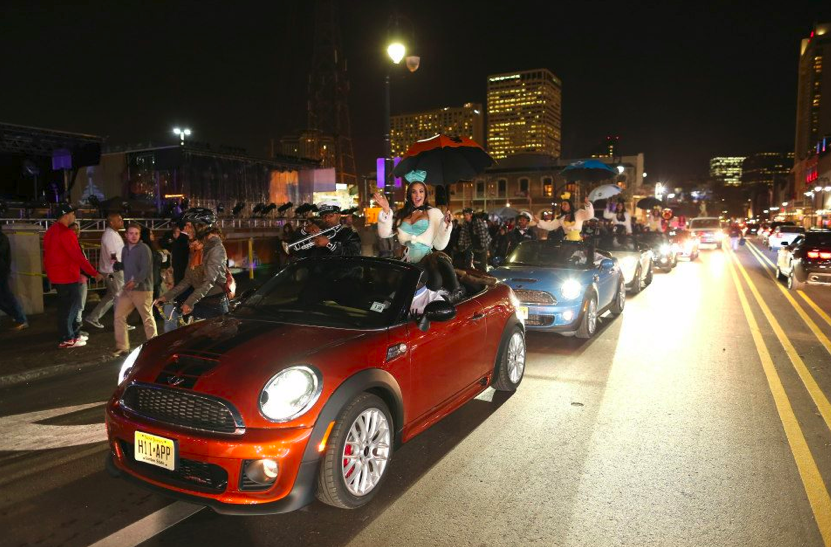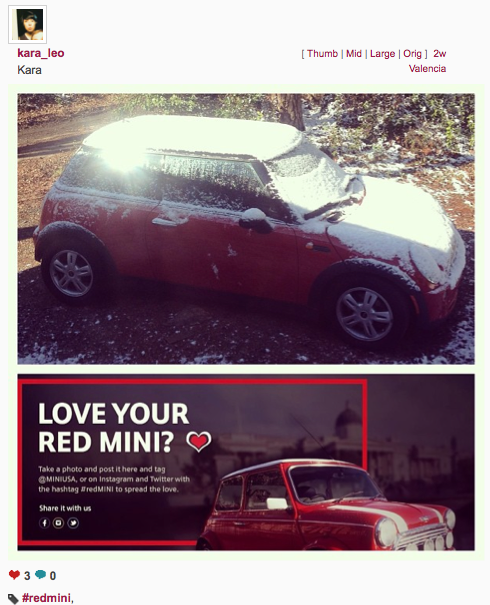
Mini USA is known for sending new owners a welcome kit with information, its Mini International magazine and some swag. Mini owners aren’t like normal folks; more than half of them have named their cars. Mini is a niche brand in a big-brand world, particularly in the U.S., where bigger means better.
That’s why its content strategy, using images, video and text, revolves around fun and isn’t shy of using the product front and center. The brand often turns to its loyalists — there are just 66,000 Minis produced each year — for content.
“It’s an approach that Mini has always taken: people who own a Mini have a real personal connection with their car and with the brand,” said Lee Nadler, marketing communications manager at Mini USA. “We want to make sure that we are playing in the right way where we keep the brand human and the voice we use is distinctly Mini, and we invite people to share their voice and share their stories.”
Mini, which is under the BMW umbrella, has cultivated a brand over the years that’s fun and quirky. For example, during the recent Mayan apocalypse, it took out a full page ad in the New York Times, with the headline, “Well, So Much For The 2014 Models.” Some of the text said, “So, if the world ends today in accordance with Mayan prophecy, you pay nothing. Ever.” And when the world didn’t end, it took out an ad the next day with the headline, “We’re Still Here,” and text, “But in light of the world not ending, you will have to make the payments.”
Mini has a content team of 20, across departments (beyond marketing, there’s customer service and PR), involved in creating and sharing content, as well as communicating with owners and prospective owners through social channels. But there are only two with “social” in their title, tasked at manning the social accounts. The company shares primarily across Facebook, uses Twitter and YouTube, and has been experimenting more with Instagram, where it sees a lot of content from car owners and dealers.
Mini posts to its 447,000 followers on Facebook, its 34,000 Twitter followers and 2,400 YouTube subscribers about five times per day but is constantly replying throughout the day. But it also leans on its car owners (450,000 of them) and its 120 dealers for Mini-branded content, encouraging them to share their stories. For example, for Valentine’s Day, the car brand posted to Facebook asking its fans to share photos of their red Mini’s via a hashtag (#RedMini) on Facebook, Twitter and Instagram.

The company also creates content from offline events. It’s currently sponsoring the Burton U.S. Open snowboarding championships in Vail, Colo. and is constantly populating its social accounts with pictures and videos from the event.

Another example of how offline activity yields online content is what it did around the Super Bowl. In tandem with Playboy, it put together a program where it sponsored Playboy’s long-running Friday night party. Mini created a mainline parade and brought in some Mini Roadsters. Placing a band member in the front seat of each car, and a Bunny on the back, the parade snaked through the French Quarter playing New Orleans music. It then posted updates, pictures and videos across its channels but also saw a large amount of content from passersby.


From Playboy’s social feeds and PR, there were 556 million impressions, five national print articles, 105 online articles and galleries, 10 broadcast segments, 14,400 Facebook mentions, 712,000 Twitter impressions and 4,700 Instagram likes. And this isn’t counting numbers from Playboy’s Playmates who shared the content. From Mini USA’s Facebook feed, it saw almost 2 million impressions, 24,000 engaged users and 5,000 people talking about it.
The company also relies on its two longtime agencies, Butler, Shine, Stern & Partners and Beam Interactive, to help build programs, assets and content to stimulate conversation.
“We work closely with them to try to be nimble, to be OK taking chances and be very quick to respond to things, and to be open when something doesn’t go too well,” Nadler said.
Beyond working with its agencies to create content, Mini also has worked with publishers to create and distribute content to that publisher’s site. It worked with BuzzFeed to expand its message beyond its owners and believes that working with publishers can help it figure out what’s happening in the publisher’s environment, why people visit and to work within the theme of that site.
Mini worked with BuzzFeed for its “Not Normal” campaign, which highlights the brand’s “individual, high-energy attitude to life.” BuzzFeed created 19 posts, like 25 Places That Look Not Normal But Are Actually Real, 20 Not Normal Uses For Everyday Things, and 13 Everyday Things With Not Normal Names. The posts generated 647,000 views.
“A brand like Mini has to always be involved and engaged in the conversation but doesn’t always have to be pushing content,” Nadler said. “We don’t force anything. We look for ways to engage and stimulate conversation.”
More in Marketing

The case for and against organic social
Digiday has delved into the debate, weighing the arguments for and against marketers relying on organic social.

Inside Google’s latest move to postpone the cookie apocalypse
Despite Google’s (most recent) assurances that it would stick to its (newest) game plan, there has been a lot going on as of late.

While Biden signs the TikTok bill, marketers still aren’t panicking
No one seems convinced (yet) that an outright ban will happen anytime soon.






